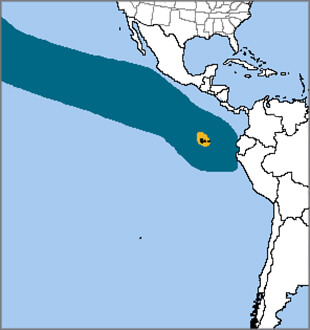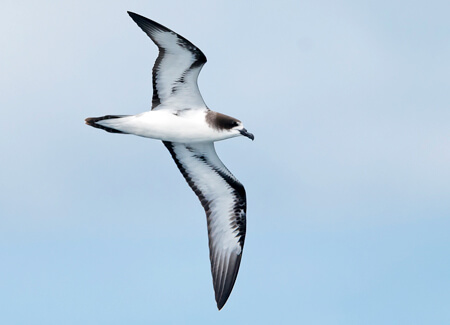 The swift-flying Galápagos Petrel is known by locals as patapegada, or "web-footed one." Once lumped with Hawaiian Petrel as a species known as the Dark-rumped Petrel, this seabird was split into a unique species in 2002 by the American Ornithologist's Union on the basis of genetic and morphologic distinctions.
The swift-flying Galápagos Petrel is known by locals as patapegada, or "web-footed one." Once lumped with Hawaiian Petrel as a species known as the Dark-rumped Petrel, this seabird was split into a unique species in 2002 by the American Ornithologist's Union on the basis of genetic and morphologic distinctions.
With long wings and a unique flight pattern, this petrel is part of a larger group of seabirds known as "gadfly" petrels. (The Black-capped Petrel of Hispaniola is also part of this group.) Gadfly petrels are named for their erratic twisting and turning flight, which makes them look as if they're trying to escape from gadflies (horseflies).
The Galápagos Petrel's aerial prowess could not protect it on its breeding islands, however, and the species faced disastrous declines of up to 80 percent when non-native mammals and plants were introduced to the Galápagos Islands.
Islands of Invasives
Predators such as dogs, cats, pigs, and rats found the burrow-nesting petrels to be easy prey and quickly decimated whole colonies, eating adults as well as chicks and eggs.
Introduced grazing animals such as horses, donkeys, and cattle trampled and destroyed nesting sites, and human settlers cleared land for agriculture and grazing on some islands. Introduced plants, such as blackberries, also grow thickly in some nest colony areas, covering over nest sites and making them unusable by the petrels.
Noisy Nocturnal Nesters
Like Short-tailed Albatross and other seabirds, Galápagos Petrels spend much of their lives at sea. They return to the humid highland areas of Santa Cruz, Floreana, Santiago, San Cristobal, and Isabela islands for their nesting season, which runs from mid-April through October.
The rocky, volcanic terrain of these islands provides plenty of natural cavities for burrow sites; mated pairs may dig their own or use an existing crevice in a crater or sinkhole. The petrels fly into their nesting areas after sunset, where their noisy, acrobatic courtship flights can be heard into the wee hours of the night.
Once the female lays her single egg, the male petrel begins incubation, allowing the female to fly out to sea to feed and regain energy. The pair takes turns tending the egg, then the male and female share chick-feeding duties, regurgitating seafood to nourish their ever-hungry chick. Petrel pairs usually remain faithful to the same nest site and mate for many years.
Unlike nocturnal-feeding seabirds such as Newell's Shearwater, Galápagos Petrels forage during the daylight hours, feeding on squid, flying fish, and crustaceans driven to the surface by tuna and porpoises.
Sign up for ABC's eNews to learn how you can help protect birds

Galápagos Petrel in flight. Photo by Kirk Zufelt
Conserving a Disappearing Seabird
Galápagos Petrels, like other seabirds, are vulnerable to light attraction, and collisions with power lines and communications towers are common as adult petrels travel to and from their nesting burrows. The impacts of climate change are not well understood for the species, but related petrels are known to be thrown off their migratory paths by hurricanes.
The Galápagos Petrel was listed under the U.S. Endangered Species Act in 2010 due to its drastic population declines. Although the Galápagos Islands are a national park and a World Heritage Site, continued control of introduced predators on these islands, along with the minimization of ongoing human impacts, are important for the species' continued survival.
American Bird Conservancy's Seabirds program is working with partners to reduce the many threats facing Galápagos Petrel and other seabirds throughout the Americas. We have collaborated in successful predator-proof fencing programs in Hawai'i that may offer a model to protect petrel colonies in the Galápagos.
ABC provides online resources to help reduce collisions, particularly with communication towers, and we continue to urge the United States to sign onto the Agreement on the Conservation of Albatrosses & Petrels.
Donate to support ABC's conservation mission!



















































